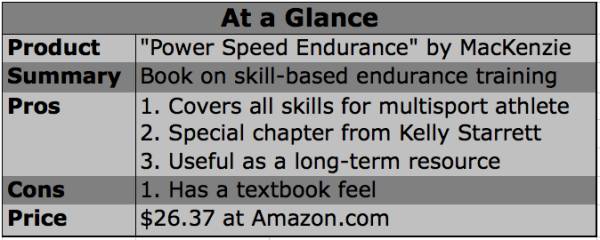
Brian MacKenzie could very well be the endurance community’s most hated antagonist and their truest savior all wrapped into one. With just one look at MacKenzie, one might expect to find a rebel underneath his heavily tattooed skin. “BMack” is the creator of a subculture called CrossFit Endurance, which combines the training protocols of CrossFit with an endurance sports focus. What’s interesting is that his “subculture” has methods and, most importantly, results that can’t be ignored by the masses.
MacKenzie’s book, Power Speed ENDURANCE, looks at endurance sports from the perspective that says better skills improve output. Especially in the world of endurance sports where the toll of bad positioning adds up over time, an athlete’s ability to hold advantageous body position is a component too critical to be left unexamined.
What I found in MacKenzie’s book was that though the conversation was most notably for endurance application, the fundamental concepts he outlines so clearly from cover to cover are universal. I’d even encourage non-endurance athletes to use this book as a resource.
The text begins with a critical overview of the CrossFit Endurance ethos. It maps out how MacKenzie arrived at the culmination of his life’s work with the concept of CrossFit Endurance. Then, the meat of the text is segmented across five skills: running, cycling, swimming, weight lifting, and mobility. The common theme throughout is efficiency by way of body position. Common faults and proper execution are thoroughly discussed for all the movements in each section. As an added bonus, Power Speed ENDURANCE includes programs to put MacKenzie’s skill-based theory into practice and train toward specific athletic achievements.
For the traditional long slow distance trainees, the efficiency drills and corrective positioning tools in this book may be enough to reel them in. I could also see runners and cyclists who maybe aren’t ready for high-intensity interval training have their interests piqued by the skill content. For other purists who are currently injured, the tools in this book could help them regain participation in the sport they love.
Myself, as more of a power athlete in practice, I found MacKenzie’s book extremely relevant. Outside of the cycling section and, in part, the swimming section, I feel like I’ll continue to look back through this text as a resource – both as a coach and an athlete. I’ll put Power Speed ENDURANCE on my bookshelf next to Greg Everett’s Olympic Weightlifting: A Complete Guide for Athletes & Coaches and Starting Strength by Mark Rippetoe.
The ideal consumer for this text need not be a strict endurance devotee. I think this text is more than the type of book you read through once. Its clear illustrations and unified theme makes moving through each skill section free and easy. The structure, however, may best support utilization as a reference piece. I, for example, will use it as a refresher course for movements I plan to teach when I coach. As an athlete, Power Speed ENDURANCE will stick around in my life as a resource for corrective drills as troubles come up in my performances.
Productivity is the name of the game in this world that we live in. If you’re concerned about your output with regards to physical activity, Brian MacKenzie should be able to help with this one. It’s my selfish hope that the endurance world grows to a universal appreciation for wholesome training like that outlined in Speed Power ENDURANCE.
“Power Speed ENDURANCE” is available on Amazon.com for $26.37.






